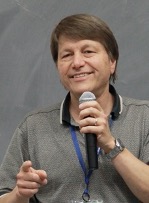Mark O. Robbins
Mark O. Robbins | |
|---|---|
 Waterville, Maine (2010) | |
| Born | |
| Died | August 13, 2020 (aged 64) |
| Nationality | American |
| Alma mater | |
| Known for | Elucidation of the fundamental origins of friction, fracture, and adhesion |
| Awards | |
| Scientific career | |
| Fields | Condensed matter physics, Computational physics |
| Institutions | |
| Doctoral advisor | Leopoldo M. Falicov[1] |
| Website | markrobbins |
Mark Owen Robbins was an American condensed matter physicist who specialized in computational studies of friction, fracture and adhesion, with a particular focus on nanotribology, contact mechanics, and polymers.[2] He was a professor in the department of physics and astronomy at Johns Hopkins University at the time of his death.[3][4]
Early life and education[edit]
Robbins was born in Indianapolis, Indiana, and was raised in Newton, Massachusetts. After completing his BA and MA degrees in physics at Harvard University in 1977, he spent a year as a Churchill Fellow at Cambridge University. He completed a Ph.D. in physics at the University of California, Berkeley in 1983.[3][4][5][6]
Career[edit]
After graduating from UC Berkeley, Robbins held a three-year appointment as a postdoctoral research fellow at Exxon Corporation's research science laboratory in New Jersey. In 1986, he joined the faculty of the department of physics and astronomy at Johns Hopkins University, where he was promoted to Associate (1988) and Full (1992) professor.[6] He served as chair of the advisory board of the Kavli Institute of Theoretical Physics (KITP) at the University of California, Santa Barbara from 2007 to 2008,[7] and chaired the Gordon Research Conference on Tribology in 2010.[8] He also served as the associate director for the Institute for Data Intensive Engineering and Science.[9]
Research[edit]
Robbins was known for his work in the application of molecular simulations to the non equilibrium phenomena of friction, fracture and adhesion. A recurring theme in his research was the elucidation of new physics on the atomic/molecular scale that could not be described by conventional continuum methods, and the use of scaling relations to predict a physical system's behavior at one length or time scale based on how it behaves at another.[5][10][11] The scope of his research included the microscopic origins of macro scale friction laws,[12][13] shear flow of fluids in nanoscale confinement,[14] the toughness of polymer adhesives[15] and the stiffness of elastic contacts.[16].
Honors and awards[edit]
- 1986 Presidential Young Investigator Award[17]
- 1987 Sloan Foundation Fellowship[18]
- 1999 Fellow of the American Physical Society, "For his contributions to our understanding of the molecular origins of friction, lubrication, spreading and adhesion."[19]
- 2018 Fellow of the American Association for the Advancement of Science, "For using simulations to reveal the microscopic origins of macroscopic behavior of matter"[20]
Personal life[edit]
Robbins was born in Indianapolis, Indiana. He was the eldest of five children raised in Newton, Massachusetts by Dorothy (Bigelow) and Owen Robbins.[4] He married Dr. Patricia McGuiggan, a materials science research professor, in 1993. They were married until his death, and had two children. After traveling to Brazil in the 1980s, Robbins developed an interest in orchids and began collecting and cultivating them at home. By 2003, his orchid collection had grown into the hundreds, and he had created two new varieties that he named after his children.[21][22] He died at his home in Baltimore, Maryland, on August 13, 2020.[3][4]
References[edit]
- ^ "Physics Tree-Mark O. Robbins Family Tree". Retrieved 2020-09-16.
- ^ Müser, Martin H. (September 1, 2021). "Editorial: In Memory of Mark Robbins". Tribology Letters. 69 (3): 1–3. doi:10.1007/s11249-021-01458-2. ISSN 1573-2711. S2CID 235191096.
- ^ a b c "Renowned condensed matter physicist Mark Robbins dies at 64". August 18, 2020.
- ^ a b c d Lee, Edward (September 6, 2020). "Dr. Mark O. Robbins, a physicist and Johns Hopkins professor, dies". Baltimore Sun.
- ^ a b "Remembering Mark Robbins". Retrieved 2020-09-28.
- ^ a b "Mark Robbins home page". Retrieved 2020-09-13.
- ^ "KITP past advisory board members". Retrieved 2020-09-13.
- ^ "2010 Gordon Research Conference on Tribology". Retrieved 2020-09-13.
- ^ "idies homepage". Retrieved 2020-09-13.
- ^ Martys, Nicos; Robbins, Mark O.; Cieplak, Marek (1991). "Scaling relations for interface motion through disordered media: Application to two-dimensional fluid invasion". Phys. Rev. B. 44 (22): 12294–12306. Bibcode:1991PhRvB..4412294M. doi:10.1103/PhysRevB.44.12294. PMID 9999384.
- ^ Jadhao, Vikram; Robbins, Mark O. (2019). "Rheological Properties of Liquids Under Conditions of Elastohydrodynamic Lubrication". Trib. Lett. 67 (3): art#66. arXiv:1903.03996. doi:10.1007/s11249-019-1178-3. S2CID 84179853.
- ^ Cieplak, M; Smith, ED; Robbins, MO (1994). "Molecular origins of friction: the force on adsorbed layers". Science. 265 (5176): 1209–12. Bibcode:1994Sci...265.1209C. doi:10.1126/science.265.5176.1209. PMID 17787586. S2CID 26280168.
- ^ He, G.; Muser, M. H.; Robbins, M. O. (1999). "Adsorbed Layers and the Origin of Static Friction". Science. 284 (5420): 1650–1652. Bibcode:1999Sci...284.1650H. doi:10.1126/science.284.5420.1650. PMID 10356390.
- ^ Thompson, PA; Robbins, MO (1990). "Shear flow near solids: Epitaxial order and flow boundary conditions". Physical Review A. 41 (12): 6830–6837. Bibcode:1990PhRvA..41.6830T. doi:10.1103/PhysRevA.41.6830. PMID 9903096.
- ^ Hoy, RS; Robbins, MO (2007). "Strain hardening in polymer glasses: limitations of network models". Physical Review Letters. 99 (11): 117801. arXiv:0705.4301. Bibcode:2007PhRvL..99k7801H. doi:10.1103/PhysRevLett.99.117801. PMID 17930472. S2CID 27613219.
- ^ Pastewka, L; Prodanov, N; Lorenz, B; Müser, MH; Robbins, MO; Persson, BNJ (2013). "Finite-size scaling in the interfacial stiffness of rough elastic contacts". Physical Review E. 87 (6): 062809. arXiv:1210.4635. Bibcode:2013PhRvE..87f2809P. doi:10.1103/PhysRevE.87.062809. PMID 23848731. S2CID 21568887.
- ^ "NSF Young Investigator Award". National Science Foundation. Retrieved 2020-09-12.
- ^ "Alfred P. Sloan Foundation past Fellows". Retrieved 2020-09-12.
- ^ "APS Fellow Archive". Retrieved 2020-09-12.
- ^ "Mark Robbins Elected as Fellow of the American Association for the Advancement of Science". December 18, 2017. Retrieved 2020-09-12.
- ^ Reinzi, Greg (November 1, 2001). "Your other life: Fulfilling Blooms". The Johns Hopkins News-Letter. Baltimore, MD: Students of Johns Hopkins. Retrieved 2020-09-17.
- ^ Hansen, Francesca C. (May 1, 2003). "Orchids root physics professor Robbins in reality". The Johns Hopkins News-Letter. Baltimore, MD: Students of Johns Hopkins. Retrieved 2020-09-17.
